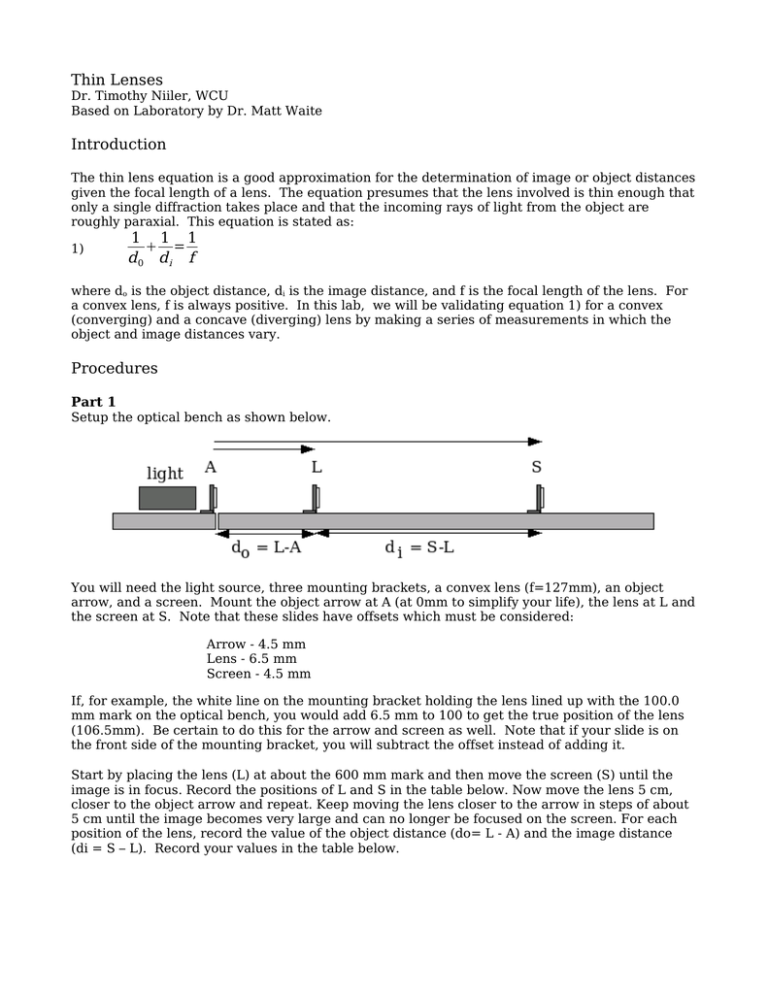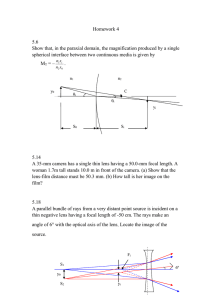Thin Lenses Introduction d0 di f Procedures
advertisement

Thin Lenses Dr. Timothy Niiler, WCU Based on Laboratory by Dr. Matt Waite Introduction The thin lens equation is a good approximation for the determination of image or object distances given the focal length of a lens. The equation presumes that the lens involved is thin enough that only a single diffraction takes place and that the incoming rays of light from the object are roughly paraxial. This equation is stated as: 1) 1 1 1 = d0 di f where do is the object distance, di is the image distance, and f is the focal length of the lens. For a convex lens, f is always positive. In this lab, we will be validating equation 1) for a convex (converging) and a concave (diverging) lens by making a series of measurements in which the object and image distances vary. Procedures Part 1 Setup the optical bench as shown below. You will need the light source, three mounting brackets, a convex lens (f=127mm), an object arrow, and a screen. Mount the object arrow at A (at 0mm to simplify your life), the lens at L and the screen at S. Note that these slides have offsets which must be considered: Arrow - 4.5 mm Lens - 6.5 mm Screen - 4.5 mm If, for example, the white line on the mounting bracket holding the lens lined up with the 100.0 mm mark on the optical bench, you would add 6.5 mm to 100 to get the true position of the lens (106.5mm). Be certain to do this for the arrow and screen as well. Note that if your slide is on the front side of the mounting bracket, you will subtract the offset instead of adding it. Start by placing the lens (L) at about the 600 mm mark and then move the screen (S) until the image is in focus. Record the positions of L and S in the table below. Now move the lens 5 cm, closer to the object arrow and repeat. Keep moving the lens closer to the arrow in steps of about 5 cm until the image becomes very large and can no longer be focused on the screen. For each position of the lens, record the value of the object distance (do= L - A) and the image distance (di = S – L). Record your values in the table below. Table 1: Determination of Focal Length of Convex Lens (be certain to include uncertainties in measured quantities). Trial Distance to Lens Distance to Screen L S do di 1 2 3 4 5 6 7 8 9 10 Analysis (Part I) Make a graph of 1/di versus 1/do where do is the object distance and di is the image distance. From this graph, estimate the focal length of the lens. Be certain to include any needed annotations on the graph (including units!). Overplot what is expected theoretically by calculating 1/di from the thin lens equation using the known focal length of the lens. Theoretically, what should the slope of your data be if your data were perfect. Why (justify this)? Explain why, physically, the x- and y-intercepts of your should be nearly equal to each other. How do the x- and y- intercepts relate to the focal length of your lens? How does this relate to the uncertainty in your derived focal length? Based on comparison of your theoretical overplot with your actual data, does your data support the thin lens equation? Explain any anomalies you might have encountered. Is the given focal length of the lens the same as your experimentally derived focal length within your margin of error? Part 2 (Procedures and Analysis) Next, mount your laser in place of the light source. Remove the object arrow, if mounted separately from the light source. Replace the convex lens with the concave lens. In this case, we are using the laser because, to first order, it provides parallel, collimated light which will follow a path as traced out in the diagram at right. Using similar triangles, it can be shown that: 2) ho hi = f f di and from this equation, the focal length, f, can be determined. The quantities ho and hi can be determined by measuring the width of the laser beam before it passes through the lens and afterwards, respectively. In this portion of the lab, it is up to you to design the experiment such that you get the most accurate value for the focal length. Do not ask your instructor to tell you what to do. Some issues to consider are whether or not the light from the laser is truly parallel, is your precision likely to be greater with larger or smaller di and hi? Does the distance between the laser and the lens matter? If so why? If not, why not. Be specific. Make as many measurements as you need to back up your arguments, and do not forget to propagate error! Do your results validate the thin lens equation?





